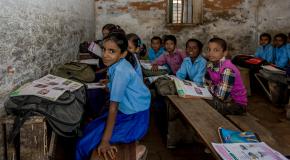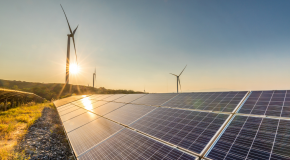Leveraging digital tools and lessons from knowledge worker companies to support students
Knowledge workers’ key skills, the digital tools they employ, and how their companies both leverage data and accommodate hybrid working can provide valuable examples for higher education institutions navigating the disruption of the pandemic. Knowledge worker companies are adaptive and employ a range of techniques for success. Learning from their approaches can help higher education with combating burnout, maintaining productivity, conducting more effective remote education, and adapting to a transformed future of teaching and learning.
17911
Related content

Fostering exploration and excellence in 21st century schools

The giving chain: How philanthropy is driving progress in Asian education
Education is widely seen as the main driver of long-term social impact in Asia, and educational philanthropists are increasingly targeting innovative projects that help marginalised and deprived communities.
How to contribute wisely to education in Asia? Read the report >>
Sparking economic progress through education
Through Q&As with luminaries in a number of sectors across the world, interviews aim to surface insights for policy makers, business leaders and other stakeholders as they consider actions to improve the quality of, and access to, education, to fortify their country’s economic, social and geopolitical fabric.
The series is supported by The International Commission on Financing Global Education Opportunity, which just presented a report urging governments to expand access to education to the UN Secretary-General, Mr Ban Ki-moon, and the Commission Co-Convenors during the UN General Assembly in New York.
The report, entitled "The Learning Generation: Investing in Education for a Changing World,” underscores the importance of quality education to address the social, economic, and security challenges of our time. For more on the report please go to educationcommission.org
Breaking the proximity bias: the future of work must be fit for all
Related content

Fostering exploration and excellence in 21st century schools

The giving chain: How philanthropy is driving progress in Asian education
Education is widely seen as the main driver of long-term social impact in Asia, and educational philanthropists are increasingly targeting innovative projects that help marginalised and deprived communities.
How to contribute wisely to education in Asia? Read the report >>
Sparking economic progress through education
Through Q&As with luminaries in a number of sectors across the world, interviews aim to surface insights for policy makers, business leaders and other stakeholders as they consider actions to improve the quality of, and access to, education, to fortify their country’s economic, social and geopolitical fabric.
The series is supported by The International Commission on Financing Global Education Opportunity, which just presented a report urging governments to expand access to education to the UN Secretary-General, Mr Ban Ki-moon, and the Commission Co-Convenors during the UN General Assembly in New York.
The report, entitled "The Learning Generation: Investing in Education for a Changing World,” underscores the importance of quality education to address the social, economic, and security challenges of our time. For more on the report please go to educationcommission.org
Getting personal: The future of education post Covid-19
Schools on both sides of the Atlantic underwent unprecedented upheaval during Covid-19, which sparked wider questions about what teaching should look like. There was a rapid expansion in home-schooling and increased political tension over curricula, but perhaps most significant of all, was the renewed interest in personalised learning – in particular the way technology can help deliver a personalised learning experience more effectively and efficiently.
Related content

Fostering exploration and excellence in 21st century schools

The giving chain: How philanthropy is driving progress in Asian education
Education is widely seen as the main driver of long-term social impact in Asia, and educational philanthropists are increasingly targeting innovative projects that help marginalised and deprived communities.
How to contribute wisely to education in Asia? Read the report >>
Sparking economic progress through education
Through Q&As with luminaries in a number of sectors across the world, interviews aim to surface insights for policy makers, business leaders and other stakeholders as they consider actions to improve the quality of, and access to, education, to fortify their country’s economic, social and geopolitical fabric.
The series is supported by The International Commission on Financing Global Education Opportunity, which just presented a report urging governments to expand access to education to the UN Secretary-General, Mr Ban Ki-moon, and the Commission Co-Convenors during the UN General Assembly in New York.
The report, entitled "The Learning Generation: Investing in Education for a Changing World,” underscores the importance of quality education to address the social, economic, and security challenges of our time. For more on the report please go to educationcommission.org
Corporations should use the pandemic to showcase science careers
Related content

Fostering exploration and excellence in 21st century schools

The giving chain: How philanthropy is driving progress in Asian education
Education is widely seen as the main driver of long-term social impact in Asia, and educational philanthropists are increasingly targeting innovative projects that help marginalised and deprived communities.
How to contribute wisely to education in Asia? Read the report >>
Sparking economic progress through education
Through Q&As with luminaries in a number of sectors across the world, interviews aim to surface insights for policy makers, business leaders and other stakeholders as they consider actions to improve the quality of, and access to, education, to fortify their country’s economic, social and geopolitical fabric.
The series is supported by The International Commission on Financing Global Education Opportunity, which just presented a report urging governments to expand access to education to the UN Secretary-General, Mr Ban Ki-moon, and the Commission Co-Convenors during the UN General Assembly in New York.
The report, entitled "The Learning Generation: Investing in Education for a Changing World,” underscores the importance of quality education to address the social, economic, and security challenges of our time. For more on the report please go to educationcommission.org
Technology and innovation environment most important for business during a crisis, finds EIU report
Related content

Hub of Business Continuity: How Asia-Pacific cities are managing during glo...

Safe Cities Index 2019
Cities across the globe are growing in size and in terms of how connected they are. Which cities are best at keeping their citizens safe and how do they do it? An updated version of the Safe Cities Index 2017, the 2019 index covers 60 cities across the globe and defines how to measure security in a rapidly urbanising world.
Visit the Safe Cities hub for more interactive content >>
Video | The Asia Pacific CEO survey
This report explores how CEOs in the Asia Pacific region are guiding their businesses through the ongoing covid-19 crisis and the steps they are taking to prepare for an uncertain future.
Related content

Financing sustainability | Insights video
What is driving the strong demand for financing sustainability in Asia Pacific? How can companies increase supply and start to see the benefits of sustainable finance in the next three years? We interviewed Richard Brandweiner, CEO of Pendal Australia, and Sophia Cheng, CIO of Cathay Financial Holdings and chair of Asia Investor Group on Climate Change, to find out.
To learn more: Download report | View infographic
Financing sustainability | Infographic
Financing sustainability: How do investors and issuers in APAC's sustainable finance market view the present market opportunities and constraints?
To learn more:
Download report | Watch video
Sustainable finance | How will covid-19 reshape key Australian industries?
Awareness that sustainability means more than reducing carbon emissions is mounting in Asia-Pacific. Evidence to the fact shows in the response of the region’s sustainable finance market to the global pandemic.
In late 2019, the market was bullish. Asia’s sustainability-related assets under management looked set to grow appreciably, and most investors saw those holdings performing better than traditional equivalents.1
Then covid-19 struck.
The crisis might have been expected to stop the market’s growth in its tracks. Volumes have indeed decreased this year, but a shifting of issuances toward sustainability areas in dire need of attention—pandemic relief and recovery—points to a market capable of adapting quickly to unexpected shocks.
To assess covid-19’s impact on sustainable finance in Asia-Pacific, we consulted representatives from key stakeholders —an issuer, an industry association and a large investor. Their consensus for longer term development is positive, but they underscore the need to address two current inhibitors in the market: a continuing shortage of supply from issuers, and insufficient clarity around definitions and reporting.
Moving beyond green
Prior to 2020, green bonds accounted for the lion’s share of sustainable financing issuances in Asia-Pacific. By mid-2020 that picture had changed considerably, mirroring a trend visible in Europe and other markets—a stark decline in green bond issuance combined with accelerated growth in social bonds.2 Matthew Kuchtyak, assistant vice president, ESG & Sustainable Finance at Moody’s Investors Service, attributes the decline in green bonds largely to reduced Chinese issuance. The pandemic-driven growth of social bonds, meanwhile, boosted that category’s share of green, social and sustainability (GSS) bond issues from 7% in the full year of 2019 to 31% in the first half of 2020, according to Moody’s data.3
1 These were among the findings of a report written by The Economist Intelligence Unit, Financing sustainability: Asia Pacific embraces the ESG challenge, published in February 2020. 2 Green bonds are used to finance or refinance projects or assets having environmental objectives, in areas such as clean energy and low-emission transport. Social bonds fund projects having social objectives, related for example to health, education or employment. Sustainability bonds target projects that combine social and environmental objectives. See Financing sustainability, page 8, for descriptions of the different types of sustainable finance instruments. 3 Data provided to The EIU by Moody’s Investors Service on September 18th 2020.Related content

Financing sustainability | Infographic
Financing sustainability: How do investors and issuers in APAC's sustainable finance market view the present market opportunities and constraints?
To learn more:
Download report | Watch video
Financing sustainability: Asia Pacific embraces the ESG challenge
Financing sustainability: Asia Pacific embraces the ESG challenge is an Economist Intelligence Unit report, sponsored by Westpac. It explores the drivers of sustainable finance growth in Asia Pacific as well as the factors constraining it. The analysis is based on two parallel surveys—one of investors and one of issuers—conducted in September and October 2019.
If the countries of Asia Pacific are to limit the negative environmental effects of continued economic growth, and companies in the region are to mitigate their potential climate risks and make a positive business contribution through improving the environment and meeting the UN's Sustainable Development Goals (SDGs), large volumes of investment in sustainable projects and businesses need to be mobilised. A viable sustainable finance market is taking shape in the region to channel commercial investor funds, and both investors and issuers say they are achieving a financial benefit from their investment and financing activities. The market is still in the early stages of development, however, and must expand and mature to meet investor needs.
The chief constraint on sustainable finance growth in the region has been the limited supply of bankable sustainable projects. Our research suggests supply is increasing, but with investor demand continuing to grow apace, the gap will remain an obstacle in the short- to medium-term. Among the organisations in our issuer survey, only 7% have used sustainable finance instruments to fund projects. However, nearly nine in ten (87%) said they intend to do so in the next year, which should begin to bridge the gap between supply and demand.
Based on issuers’ stated intentions, investors will have a range of instruments to choose from, including green loans and bonds and sustainability loans and bonds. Large numbers of investors indicate that they intend to deploy a greater proportion of capital to these over the next three years.

Sustainable finance | How will covid-19 reshape key Australian industries?
Awareness that sustainability means more than reducing carbon emissions is mounting in Asia-Pacific. Evidence to the fact shows in the response of the region’s sustainable finance market to the global pandemic.
In late 2019, the market was bullish. Asia’s sustainability-related assets under management looked set to grow appreciably, and most investors saw those holdings performing better than traditional equivalents.1
Then covid-19 struck.
The crisis might have been expected to stop the market’s growth in its tracks. Volumes have indeed decreased this year, but a shifting of issuances toward sustainability areas in dire need of attention—pandemic relief and recovery—points to a market capable of adapting quickly to unexpected shocks.
To assess covid-19’s impact on sustainable finance in Asia-Pacific, we consulted representatives from key stakeholders —an issuer, an industry association and a large investor. Their consensus for longer term development is positive, but they underscore the need to address two current inhibitors in the market: a continuing shortage of supply from issuers, and insufficient clarity around definitions and reporting.
Moving beyond green
Prior to 2020, green bonds accounted for the lion’s share of sustainable financing issuances in Asia-Pacific. By mid-2020 that picture had changed considerably, mirroring a trend visible in Europe and other markets—a stark decline in green bond issuance combined with accelerated growth in social bonds.2 Matthew Kuchtyak, assistant vice president, ESG & Sustainable Finance at Moody’s Investors Service, attributes the decline in green bonds largely to reduced Chinese issuance. The pandemic-driven growth of social bonds, meanwhile, boosted that category’s share of green, social and sustainability (GSS) bond issues from 7% in the full year of 2019 to 31% in the first half of 2020, according to Moody’s data.3
1 These were among the findings of a report written by The Economist Intelligence Unit, Financing sustainability: Asia Pacific embraces the ESG challenge, published in February 2020. 2 Green bonds are used to finance or refinance projects or assets having environmental objectives, in areas such as clean energy and low-emission transport. Social bonds fund projects having social objectives, related for example to health, education or employment. Sustainability bonds target projects that combine social and environmental objectives. See Financing sustainability, page 8, for descriptions of the different types of sustainable finance instruments. 3 Data provided to The EIU by Moody’s Investors Service on September 18th 2020.Education | How will covid-19 reshape key Australian industries?
A recent report by the Mitchell Institute at Victoria University titled Australian Investment in Education: Higher Education shows that 40% of Australia’s annual university student revenue is derived from international students. This demographic provides almost A$9bn (US$5.9bn) to universities and injects another A$10bn (US$6.5bn) into the broader economy. The report also notes that most universities had limited surpluses to steer them through the covid-19 contraction.
Figure 1: University domestic and international student revenue (actual and forecast)
17423
Related content

Financing sustainability | Insights video
What is driving the strong demand for financing sustainability in Asia Pacific? How can companies increase supply and start to see the benefits of sustainable finance in the next three years? We interviewed Richard Brandweiner, CEO of Pendal Australia, and Sophia Cheng, CIO of Cathay Financial Holdings and chair of Asia Investor Group on Climate Change, to find out.
To learn more: Download report | View infographic
Financing sustainability: Asia Pacific embraces the ESG challenge
Financing sustainability: Asia Pacific embraces the ESG challenge is an Economist Intelligence Unit report, sponsored by Westpac. It explores the drivers of sustainable finance growth in Asia Pacific as well as the factors constraining it. The analysis is based on two parallel surveys—one of investors and one of issuers—conducted in September and October 2019.
If the countries of Asia Pacific are to limit the negative environmental effects of continued economic growth, and companies in the region are to mitigate their potential climate risks and make a positive business contribution through improving the environment and meeting the UN's Sustainable Development Goals (SDGs), large volumes of investment in sustainable projects and businesses need to be mobilised. A viable sustainable finance market is taking shape in the region to channel commercial investor funds, and both investors and issuers say they are achieving a financial benefit from their investment and financing activities. The market is still in the early stages of development, however, and must expand and mature to meet investor needs.
The chief constraint on sustainable finance growth in the region has been the limited supply of bankable sustainable projects. Our research suggests supply is increasing, but with investor demand continuing to grow apace, the gap will remain an obstacle in the short- to medium-term. Among the organisations in our issuer survey, only 7% have used sustainable finance instruments to fund projects. However, nearly nine in ten (87%) said they intend to do so in the next year, which should begin to bridge the gap between supply and demand.
Based on issuers’ stated intentions, investors will have a range of instruments to choose from, including green loans and bonds and sustainability loans and bonds. Large numbers of investors indicate that they intend to deploy a greater proportion of capital to these over the next three years.

Financing sustainability | Infographic
Financing sustainability: How do investors and issuers in APAC's sustainable finance market view the present market opportunities and constraints?
To learn more:
Download report | Watch videoThe coming “relevance renaissance” in higher education
Related content

Fostering exploration and excellence in 21st century schools

The giving chain: How philanthropy is driving progress in Asian education
Education is widely seen as the main driver of long-term social impact in Asia, and educational philanthropists are increasingly targeting innovative projects that help marginalised and deprived communities.
How to contribute wisely to education in Asia? Read the report >>
Sparking economic progress through education
Through Q&As with luminaries in a number of sectors across the world, interviews aim to surface insights for policy makers, business leaders and other stakeholders as they consider actions to improve the quality of, and access to, education, to fortify their country’s economic, social and geopolitical fabric.
The series is supported by The International Commission on Financing Global Education Opportunity, which just presented a report urging governments to expand access to education to the UN Secretary-General, Mr Ban Ki-moon, and the Commission Co-Convenors during the UN General Assembly in New York.
The report, entitled "The Learning Generation: Investing in Education for a Changing World,” underscores the importance of quality education to address the social, economic, and security challenges of our time. For more on the report please go to educationcommission.org
Finland leads for the second year globally in providing future-skills education for youth, according to the 2019 Worldwide Educating for the Future Index (WEFFI)
Related content

Fostering exploration and excellence in 21st century schools

The giving chain: How philanthropy is driving progress in Asian education
Education is widely seen as the main driver of long-term social impact in Asia, and educational philanthropists are increasingly targeting innovative projects that help marginalised and deprived communities.
How to contribute wisely to education in Asia? Read the report >>
Sparking economic progress through education
Through Q&As with luminaries in a number of sectors across the world, interviews aim to surface insights for policy makers, business leaders and other stakeholders as they consider actions to improve the quality of, and access to, education, to fortify their country’s economic, social and geopolitical fabric.
The series is supported by The International Commission on Financing Global Education Opportunity, which just presented a report urging governments to expand access to education to the UN Secretary-General, Mr Ban Ki-moon, and the Commission Co-Convenors during the UN General Assembly in New York.
The report, entitled "The Learning Generation: Investing in Education for a Changing World,” underscores the importance of quality education to address the social, economic, and security challenges of our time. For more on the report please go to educationcommission.org




